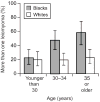Prevalence of uterine leiomyomas in the first trimester of pregnancy: an ultrasound-screening study
- PMID: 19300327
- PMCID: PMC3384531
- DOI: 10.1097/AOG.0b013e318197bbaf
Prevalence of uterine leiomyomas in the first trimester of pregnancy: an ultrasound-screening study
Abstract
Objective: To estimate the proportion of pregnant women with one or more leiomyomas detected by research-quality ultrasound screening in the first trimester, to describe the size and location of leiomyomas identified, and to report variation in prevalence by race/ethnicity.
Methods: Within an ongoing prospective cohort, we conducted 4,271 first-trimester or postmiscarriage ultrasound examinations. Sonographers measured each leiomyoma three separate times, recording the maximum diameter in three perpendicular planes each time. Sonographers and investigators classified type and location.
Results: Among 458 women with one or more leiomyomas (prevalence 10.7%), we identified a total of 687 leiomyomas. The mean size of the largest leiomyoma was 2.3 cm (95% confidence interval [CI] 1.8-2.8). Mean gestational age at ultrasonography was 61+/-13 days from last menstrual period. Prevalence varied by race/ethnicity: 18% in African-American women (95% CI 13-25), 8% in white women (95% CI 7-11), and 10% in Hispanic women (95% CI 5-19). The proportion of women with leiomyomas increased with age much more steeply for African-American women than for white women.
Conclusion: Leiomyomas are common in pregnancy and occur more often among African-American women. Given the limited research on effects of leiomyomas on reproductive outcomes, the degree to which race/ethnic disparities in prevalence of leiomyomas may contribute to disparities in events such as miscarriage and preterm birth warrants investigation.
Conflict of interest statement
Figures


References
-
- Benson CB, Chow JS, Chang-Lee W, Hill JA, III, Doubilet PM. Outcome of pregnancies in women with uterine leiomyomas identified by sonography in the first trimester. J Clin Ultrasound. 2001;29:261–264. - PubMed
-
- Coronado GD, Marshall LM, Schwartz SM. Complications in pregnancy, labor, and delivery with uterine leiomyomas: a population-based study. Obstet Gynecol. 2000;95:764–769. - PubMed
-
- Katz VL, Dotters DJ, Droegemeuller W. Complications of uterine leiomyomas in pregnancy. Obstet Gynecol. 1989;73:593–596. - PubMed
-
- Klatsky PC, Tran ND, Caughey AB, Fujimoto VY. Fibroids and reproductive outcomes: a systematic literature review from conception to delivery. Am J Obstet Gynecol. 2008;198:357–366. - PubMed
-
- Lev-Toaff AS, Coleman BG, Arger PH, Mintz MC, Arenson RL, Toaff ME. Leiomyomas in pregnancy: sonographic study. Radiology. 1987;164:375–380. - PubMed
Publication types
MeSH terms
Grants and funding
LinkOut - more resources
Full Text Sources
Other Literature Sources
Medical

